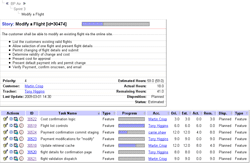Optimized Use Cases
Use cases have been around for some time now, bursting onto the public spotlight at the 1987 OOPSLA conference in Orlando. Since that time they’ve been used in countless projects. In some situations use cases have excelled, producing remarkable results while in many others they’ve failed miserably. Use cases have what seems to be an endless stream of textbooks and articles written about them which, especially to those new to the subject, can be overwhelming and confusing.
One missing piece to this equation was the fact that requirements definition as a professional discipline has been underserved until recently by the industry and by software tool vendors. Communities, professional organizations, and modern software toolsets are now finally available for requirements authors and to support the requirements lifecycle. Some of these tools bring new and innovative capabilities not imagined before, and as they get applied to existing approaches like use cases, new sets of best practices emerge. This article examines some use cases best practices learned from using Blueprint Requirements Center on real projects.
Fundamentals
Less is More
One of the most unfortunate habits of requirements authors is the belief that providing greater quantities and more detailed information is a good thing. The goal with requirements is to communicate precisely what is needed, and for the information to be completely and accurately understood by the consumer. Unfortunately many authors feel the more information they can stuff into the document and the more detail they provide, the better job they’re doing.
Example: Pretend for a moment that you just got the job of running the county. Tourists arrive with the goal of discovering the area – its culture, character, history, attractions, and so on. Your job is to help them achieve this goal. In your enthusiasm you start creating brochures detailing the various aspects of the county. And you keep on making brochures. So many that you end up with hundreds that cover every mundane little thing in the area. After a month of operation you discover there’s no pattern to the brochures taken – one from here, one from there. Something like 90% of the brochures haven’t even been touched. Surveys of tourists show no consistency in their perceptions of the county – it’s almost like the different tourists have visited different counties entirely. To summarize the results of this:
- The goal of communicating the unique culture and character of the area wasn’t met;
- Visitors all left with very different impressions and understandings of the county;
- You spent a lot of time, effort, and money providing information and 90% of it wasn’t even used.
This example is much like the requirements situation on many projects and organizations. “Information overload” is a huge problem. So often the answer to every issue and misinterpretation in requirements documents is to add more content in order to ‘elaborate’ and ‘clarify’. Simply adding more content is generally counter-productive, often doing more harm than good by introducing conflicting information, inconsistencies, and redundancies. When authoring requirements you should always put yourself in the position of the consumer. You should strive to communicate what’s needed using the smallest volume of content possible. Since even this can be considerable in size, you also should strive to make that content navigable. This means you should structure the content so that readers know where to start and how to traverse the content in order to best understand what’s being communicated. While this takes skill and effort on behalf of the requirements author, the positive effects on the software project can be dramatic.
Know Your Boundaries
If I had to pick one aspect of use case models that people should ensure they do right, it would be to have a good understanding among all stakeholders of what the system boundary is. For some applications it’s obvious and apparent, while for others it can be quite the opposite. Since a use case documents a dialog that spans this boundary, not having a good understanding of it can severely reduce the clarity of your requirements. For those who rely on the use case model to do their work, people like designers and testers, their work-products will suffer similarly.
Fantasy vs. Reality. Try Bottom-Up
For those new to the use case approach, it’s easy to get lost in use cases with unusual terms like, includes, extends, actors, associations, models, and so on. With so much focus on learning to navigate this new and imaginary world, it’s easy to lose sight of the real world it’s supposed to represent. Developing work-habits that regularly move you back and forth between the two can help keep your modeling work grounded in reality.
Use cases do of course provide many benefits, not the least of which is to clearly identify a higher purpose for a collection of steps and decisions, to answer the question “why are we doing these actions”. So, where a group of steps and decisions together fulfill some goal of an external user, we group them and that becomes a use case. Where a flow crosses from one group to another, this becomes a relationship. If the flow came from a decision it’s an “extends” relationship. Otherwise, it’s an “Include” relationship.
There is typically little debate over what the actions and decisions are as this is simply the real-world work that needs to get done. On the contrary, there is often debate over what the use cases are, since these are abstract groupings of the real-world steps and decisions, and one person could come up with a different grouping than the next person. For multiple people to independently group the steps and decision and come up with a comparable set of use cases is an indication of a well-understood problem space.
It’s important when modeling to not lose sight of the real world which is the subject of your model.
Modeling Style
There are many different styles of modeling. Some modeling styles, for example, make use of decomposition, where abstract actions or steps are decomposed into finer detail contained in included use cases. There is much debate over whether decomposition with use cases is a good idea or not. It is simply one approach. One advantage it offers is to allow readers to “adjust” the level of detail at which they work at will – work at a high level, or follow the path of decomposition to drill into the details of a specific action. One objection to its use is that it will influence the developers who work from the use cases toward implementations that are not object-oriented in nature.
Think Like a Tester
Tests are very similar to requirements. Both are really just descriptions of “what the system is supposed to do.” So if they’re talking about the same piece of software then they need to be completely consistent. Some, in fact, hold the point of view that tests are really just a more detailed form of the requirements. Looking at the requirements from the perspective of a tester can be very valuable for detecting issues early. In particular I’ve found the tester’s perspective can help a great deal in defining the system boundary. This is because testing is all about providing “stimulus” to some “thing” and then observing that “thing’s” behavior in response, so the borders of where the “thing” begins and ends need to be clear, and testers are great at thinking this way. A second area where I’ve found testers to be a great help in requirements definition is thinking of exception cases. Stakeholders and business analysts tend to be very good at identifying what the system should do when things go right, but experienced testers excel at thinking of all the possible ways that things can go wrong. Having this knowledge up-front means it can be accounted for and influence the requirements while they’re being defined, as opposed to being an after-thought late in the cycle. In addition to the tester as an individual, modern requirements toolsets that can automatically generate tests provide tremendous value as well. When reviewing requirements – actually even when authoring them – these tools allow the corresponding tests to be instantly generated and used to provide another litmus-test for requirements quality. Often inconsistencies and errors can be spotted in the generated tests that were missed when reviewing just the requirements.
Be Expressive
Use cases are our tool for communicating what is to be built. To achieve this you need to be as expressive as possible with use cases. No matter how good you are with words, written text can only go so far. One of the easiest yet most effective ways is to mockup potential user interfaces for the steps of the use case. In other words, render the more significant aspects of the user interface as it evolves through a use case. Most often this will just be simple sketches, but where appropriate can be higher-fidelity visualizations. Together this set of mockups will form a storyboard for the various scenarios. If the nature of the project is enhancing an existing application, screen-shots of the existing application can serve as the starting point, then annotate, markup, or add new screen controls as needed. Shifting focus onto storyboards as opposed to the text of the use case flows can make reviews significantly more effective. As with test generation mentioned earlier, there are tools now that support this more visual approach to defining use cases.
Another way to be more expressive is with data or information. Where the use case effects or transforms data in the application or where data influences the behavior of the use case, instead of describing this in text, modern requirements tools will actually allow you to encode these calculations and updates. During a simulation session not only will the visualizations be shown but samples of real data can be entered, displayed and calculated similar to the real application. Together this has the effect of bringing the story to life as opposed to forcing reviewers to imagine it from textual use cases.
Another example of increasing the expressiveness of the use cases again is provided with modern automation. There is typically a large amount of reference material on a typical software project related to the requirements. This can be standards, guidelines, regulations, vision documents, operational documents, and more. Tools today can automatically open, navigate to relevant content, and highlight it when these references are called upon. This automatically brings relevant content into the discussion as opposed to leaving it buried off to the side where important aspects could be missed.
The Bigger Picture
Where Do They Come From?
Let’s say I came up to you and said, “Hey, please make me three or four detailed use cases. I’ll be back after lunch to pick them up, and I expect them to be correct!” Your chances of delivering what I need are pretty much zero. You need to find out what my goals are for the application, what the application is to be used for, what major decisions will I need it to support, is this enhancing something that exists or is it new, are there any constraints, are there any special needs like security or safety, and other questions like this. In other words, you have some work to do before you get to the use cases. Typically this results in textual, hierarchical lists of goals, rules and other categorizations of need, and often sketches of the business processes in which the application is to play a part.
So I’ve Made Some Use Cases. Now What ?
After creating use cases, you’ll need them to be reviewed with the client whom the application is for, and also with the people that are to build and test the application. Reviews of requirements are one of the most crucial control points in the software lifecycle. It’s an opportunity to point the project in the right direction, and to do so early. Errors missed in reviews are simply errors whose discovery has been delayed – they will eventually be found, just later when they’re more expensive to fix. The effectiveness of the review depends on how well the requirements can be communicated. The more expressive the requirements, the more likely they’ll be communicated clearly. Another major way to be more expressive, is to use simulation during reviews. Modern Requirements Definition toolsets support simulation of requirements where the requirements can be “brought to life” to give an impression of how the future application, if built to these requirements, will look, feel, and behave. After all, most people when reading requirements are in fact performing a simulation in their minds trying to visualize the future application to help decide if this requirement document is acceptable. The problem is that in their minds’ simulation things are missed, all the interactions cannot be accounted for, and perhaps worst of all everyone has a somewhat different vision depending on how they interpret the written text. Automated simulation, projected for all to see, has none of these issues and provides all the benefits – literally a common vision.
Not only is communication vital during reviews to get the requirements right, but it’s also vital for those who will build and test the application to understand what they need to do. Any miscommunication here means people will go off in the wrong direction with their work. Simulation is a very good tool for this as well. Once they do understand however, they actually need access to the use cases and associated requirements information to do their work, since their tasks depend upon this information. These are areas where modern tools can really make a difference, in a number of ways.
First, tools today can automatically generate tests directly from use cases. This is a huge time-saver. Not only is the work done automatically, but it’s correct. Even more advanced tools allow you to filter the set of tests produced to focus only on those of high-risk, or the most business-critical.
Second, requirements definition tools today also can auto-populate the tools used by the designers and testers with the requirements, and tests, produced using the requirements definition tool. This avoids transcription errors and oversights that often happen when you deliver a document, and the practitioner needs to manually enter relevant information into their toolset.
Third, requirements definition tools today can automatically generate the documentation you need, either because your process calls for it, or to comply with corporate standards. Document generation governed by templates allows you to define entirely the format and content of the documents. More advanced tools can even automatically produce redlined documents showing changes since some previous version like the last review session, for example.
Conclusion
There have been significant gains made in requirements definition tools in recent years. This perhaps shouldn’t be surprising given that this area, arguably one of the most crucial for determining the success of software projects, was neglected by software tool vendors for decades. These advancements, coupled with best practices learned by applying this new technology in real and complex projects, has the potential to clear the log-jam of software project failures that has plaguing the industry for years.
Don’t forget to leave your comments below
Tony Higgins is Vice-President of Product Marketing for Blueprint, the leading provider of requirements definition solutions for the business analyst. Named a “Cool Vendor” in Application Development by leading analyst firm Gartner, and the winner of the Jolt Excellence Award in Design and Modeling, Blueprint aligns business and IT teams by delivering the industry’s leading requirements suite designed specifically for the business analyst. Tony can be reached at [email protected].


